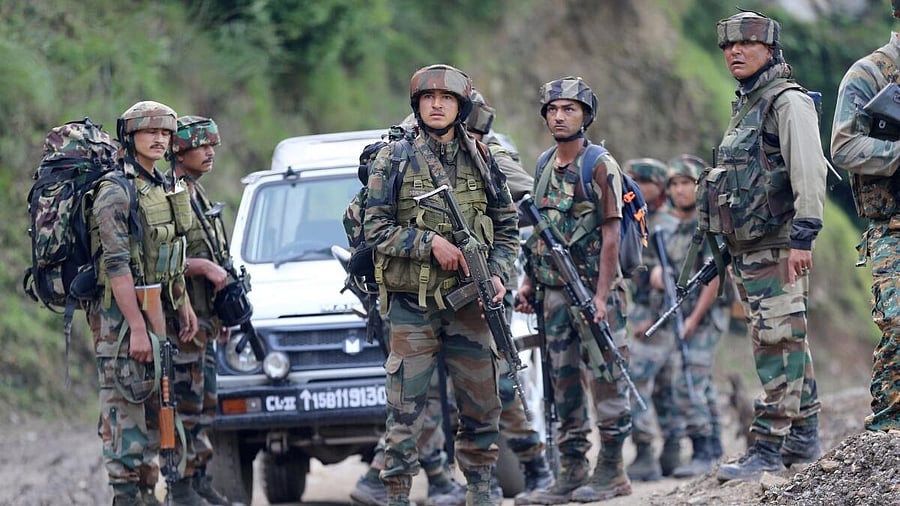
Indian Army personnel
Credit: PTI Photo
By Mihir Sharma
India’s purchase of 26 Rafale jets from France’s Dassault Aviation SA cannot conceal the fact that its military is sleepwalking into a crisis. Strategic indecision and an addiction to short-termism have left its armed forces unprepared for the challenges ahead.
The new planes will certainly fill an obvious gap in the military’s needs — its two aircraft carriers are dependent on 40 elderly Russian-made MiG-29Ks, of which perhaps half are reportedly serviceable at any given time. But instead of solving India’s problems of preparedness, this decision actually reveals their daunting scale.
The real issue isn’t the navy but the Indian Air Force, which is known to be understrength and will likely be even less capable a few years from now unless New Delhi starts thinking long term. Scholars such as the Stimson Center’s Christopher Clary have warned that India is “underbalancing” China, both before and after deadly clashes along their disputed Himalayan border in 2020.
The problem is, defense planners don’t like to spell out what the air force needs. The IAF is supposed to have 45, or at worst 42 squadrons, of 18 aircraft each. Today it would struggle to rustle up 32, and many of those would be one or two planes shy of their full complement. Some of these are ancient MiG-21s, which are due to be phased out this year. India may be left with only 25 or 26 active squadrons by the end of the decade.
The Pakistan Air Force, meanwhile, is supposedly in negotiations with Beijing to buy 40 J-35A fifth-generation fighters. There’s general doubt in New Delhi that the Chinese will be willing and able to make Pakistan the first export destination for their prized jet, or that cash-strapped Islamabad will be able to pay for them. But some quietly worry that, if the deal somehow goes through, India’s overstretched air force could be outmatched not just by China’s but by Pakistan’s.
How could it have gone so wrong for an IAF that, a few decades ago, was proud of its preparedness? Part of the problem lies with its timid and tight-lipped defense planners, and part with a government that’s simply unwilling to pay the political and economic costs of military modernization.
New planes are expensive. The Rafales for the navy will cost $7.4 billion. That will already stretch the defense procurement budget, and somehow officials will have to find the money for another 100-plus planes for the air force. But Prime Minister Narendra Modi’s fiscal conservatism has left defense spending at historical lows as a proportion of gross domestic product, and his political populism means too much of that is tied to unsustainable pension plans.
Adding to the difficulties, the defense establishment is inefficient even by the standards of the Indian state. Indigenous fighters, developed and manufactured by state-run Hindustan Aeronautics Ltd, were supposed to pick up the slack for the IAF and the navy. The military claims that HAL fails to deliver on time and to spec; the engineers complain that the military changes its mind and has unrealistic expectations.
The last time India tried to buy fighters on the open market, the tendering process took so long that Modi was forced to purchase 34 Rafales in a deal that he struck with the French government. That agreement — sans most of India’s usual demands, such as local manufacturing and technology transfer — was urgent because planners determined at least some new jets were needed for India’s nuclear deterrent.
It also caused some domestic political controversy. Defense scandals have brought down governments; the fear of corruption tends to paralyze the bureaucracy. Officials dread an open and structured procurement process, and would much rather the prime minister take the political risk of buying a plane directly.
This unwillingness to go through a proper deliberation and make a transparent choice is a disservice to India — because it leads to strategic indecision. We don’t have answers to basic questions: How many planes do we need, and how modern do they have to be? Can we make do with cheaper indigenous fighters for a decade? Can we rule out buying more Russian hardware? Will we have to keep the Americans happy by buying the F-35, as President Donald Trump clearly wants? Are we now locked into the Rafale, which is expensive and produced entirely in France? Or can we go with one of the other European alternatives, such as the Eurofighter Typhoon or Sweden’s Gripen, which might suit our circumstances far better?
Emergency, piecemeal purchases simply won’t cut it. The IAF needs political direction and cover so it can produce a plan that takes it into the next decades — one that includes technology transfer and localized supply chains of the sort that we know, post-Ukraine, is vital if you get into a war. Whatever option delivers this is the one India must go with — and it can’t put off making a clear choice for much longer, or it will find itself outmatched in the sky.